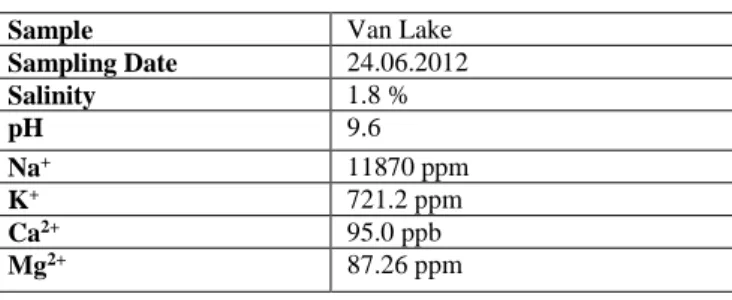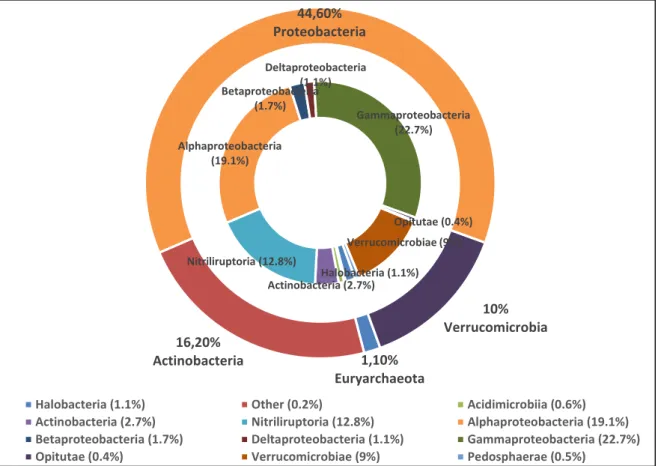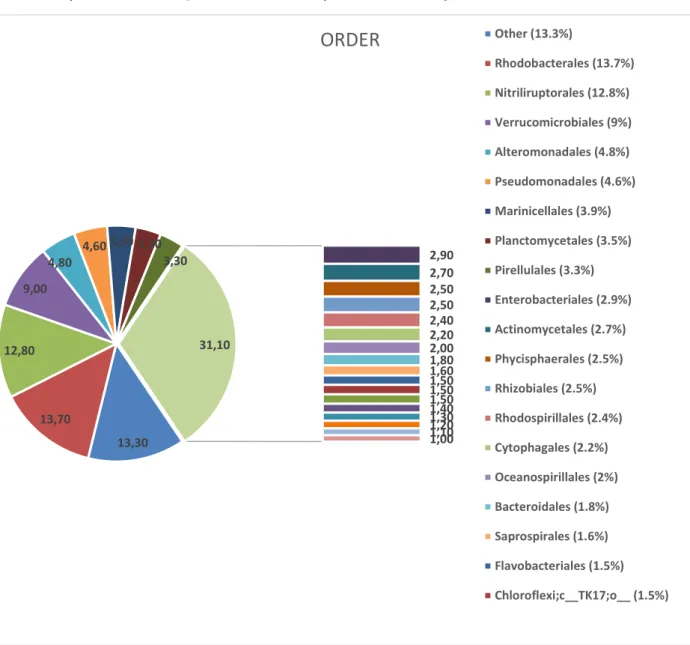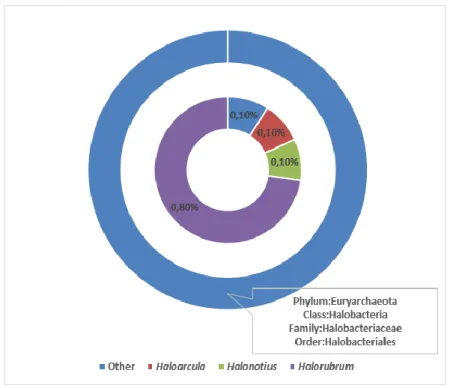C- YAŞAM BİLİMLERİ VE BİYOTEKNOLOJİ
Eskişehir Technical University Journal of Science and Technology C- Life Sciences and Biotechnology
2020, 9(1), pp. 80 - 88, DOI: 10.18036/estubtdc.680795
nilgun.kavak@dpu.edu.tr
CHARACTERIZATION OF MICROBIAL POPULATIONS OF LAKE VAN BY 16S METAGENOMICS STUDY
Nilgün POYRAZ 1, *, Mehmet Burçin MUTLU 2
1 Department of Biology, Faculty of Science and Humanities, Kütahya Dumlupınar University, Kütahya, Turkey 2 Department of Biology, Faculty of Science, Eskişehir Technical University, Eskişehir, Turkey
ABSTRACT
Van Lake, located in Eastern Anatolia Region, is the largest lake in Turkey. This lake features alkaline and saline soda lake. Since there are few studies focused on microbial diversity of alkaline environments, it is very important to reveal the diversity of microorganisms of Van Lake because of the wide range of biotechnological uses of these microorganisms and their ecological roles in lake ecosystem.
Next generation sequencing (NGS) allow us to sequence DNA and RNA much more quickly and cheaply than the previously used Sanger sequencing for the rapid analysis of the composition and diversity of microbial communities in several habitats. We applied the high throughput techniques of NGS to the metagenomics study of Van Lake, by assessing its PCR amplicon of 16S rDNA sequences (V3–V4 regions). The analyses revealed Proteobacteria, Actinobacteria and Verrucomicrobia phyla were most abundant. Archaea members were represented by Euryarchaeota phylum. Results concluded that Bacteria domain were dominant in Van Lake.
Keywords: Van Lake,16S rRNA, Microbial diversity, Illumina Sequencing
VAN GÖLÜ MİKROBİYAL POPULASYONLARININ 16S METAGENOM ÇALIŞMASI İLE KARAKTERİZASYONU
ÖZET
Doğu Anadolu Bölgesi'nde bulunan Van Gölü, Türkiye'nin en büyük gölüdür. Bu göl alkali ve tuzlu soda gölüdür. Alkali ortamların mikrobiyal çeşitliliğine odaklanan az sayıda çalışma olduğu için, bu mikroorganizmaların geniş biyoteknolojik kullanımları ve göl ekosistemindeki ekolojik rolleri nedeniyle Van Gölü'nün mikrobiyal çeşitliliğini ortaya koymak çok önemlidir.
Yeni nesil dizileme (NGS), bazı habitatlarda mikrobiyal toplulukların kompozisyon ve çeşitliliğinin hızlı analizi için daha önce kullanılan Sanger dizilemesinden çok daha hızlı ve ucuz bir şekilde DNA ve RNA dizilememizi sağlar. Çalışmamızda 16S rDNA sekanslarının (V3-V4 bölgeleri) PCR amplikonlarını değerlendirerek Van Gölü’nün metagenomik analizi kapsamında, yüksek verimli NGS uygulanmıştır. Analizler Proteobacteria, Actinobacteria ve Verrucomicrobia filumlarının baskın olduğunu göstermiştir. Archaea üyeleri ise Euryarchaeota filumu tarafından temsil edilmiştir. Sonuçlar Van Gölü'nde Bacteria domaininin baskın olduğunu ortaya çıkarmıştır.
Anahtar Kelimeler:Van Gölü, 16S rRNA, Mikrobiyal çeşitlilik, Illumina dizileme
1. INTRODUCTION
Van Lake Basin is one of the basins located in the East Anatolian Plateau and has Van Lake, the largest soda lake in the world [1]. Van Lake, or Van Gölü in Turkish, is located in the eastern Anatolia, Turkey. It is in the location at 38° 38′ N, 42° 49′ E [2]. Van Lake is the largest soda lake in the world with a volume of 607 km3 and a depth of 451 m [3] and by volume the fourth largest closed body of water on Earth. The pH value is around 9.7-9.8 and the salinity is quite high. Sodium carbonate and NaCl form salinity in large proportions. It also contains sulfate, potassium and magnesium [4]. Soda lakes are highly alkaline environments and contain too many alkaline microorganisms [5]. In soda lakes major factor is
salinity for microbial community composition [6]. Representatives of alkaline microorganisms undergo carbon, sulfur and nitrogen cycling under aerobic and anaerobic conditions in lakes.
Most of the microbial diversity studies to date have been carried out with traditional cultural and taxonomic procedures. 16S rDNA clone libraries were performed and isolates were identified with 16S rRNA genes [7]. Denaturing gradient gel electrophoresis (DGGE) were applied to study population diversity [8]. Functionally microbial communities in soda lakes have been well studied and microbial groups in biochemical cycles have been studied [9]. Alphaproteobacteria and Gammaproteobacteria,
Firmicutes, Bacteroidetes, Cyanobacteria, and several purple phototropic bacteria were dominant in
soda lakes [10], [11].
No detailed studies have been carried out on microbial diversity of soda lakes in Turkey. Although Lake Van is the largest lake in Turkey, only a few studies have been made on its microbial diversity and ecology. Previous works for Van Lake investigated bacterial diversity of microbiolite samples [12] and one other study used culture-dependent methods for characterization of enzymes and protein from alkaliphilic Bacillus [13]. A recent study was conducted to determine the microbial diversity of Lake Van by using both culture-dependent and culture-independent molecular methods such as Fluorescein in situ hybridization (FISH) and Denaturing gradient gel electrophoresis (DGGE) [14].
Studies of Lake Van have improved our knowledge on biology of lake and could lead to discovery of novel microorganisms and enzymes have a great potential for biotechnological applications. It is also known that in lake ecology, bacteria play a role in the food chain and contribute to the carbon cycle [15]. Therefore, the aim of the present study was to assess detailed information on the phylogenetic diversity of the microbial community in Lake Van. For this purpose, in this work, we used 16S metagenomics approach to have more detailed information of microbial diversity.
2. MATERIALS AND METHODS 2.1. Study Site and Sample Collection
The water sample used in the study was taken from the coast of Lake Van. The salinity of the sample was measured by hand refractometer (Eclipse), pH was measured by pH meter (Mettler Toledo Schwerzenbach, Switzerland). Some of the elements contained in the water sample were determined by the ICP (Perkin Elmer Optical Emission Spectrometer Optima 4300 DV) device of Anadolu University Center for Plant Medicine and Scientific Research (BİBAM).
2.2. DNA Extraction and Quantification
For investigation of microbial community total DNA was extracted from water sample using a modified manuel method as described previously [16], [17], [18]. Concentration of extracted DNA was measured using a Nanodrop. The quality of the DNA was determined by measuring of A260/A280 and A230/A260 ratios.
2.3. Amplicon Sequencing
The obtained DNA was used to investigate microbial diversity using specific primers for the V4 region of 16S rRNA (5'-GTGCCAGCMGCCGCGGTAA-3') and 806R (5'-GGACTACHVGGGTTTCTAAT-3'). For genomic DNA amplification, the barcode primer set conforming to the protocols recommended in the "Earth Microbiome Project" was used as adapted to the Illumina MiSeq device. (http://www.earthmicrobiome.org/emp-standard-protocols/16s/). Primers specific to the V4 region of 16S rRNA were also applied to include the "Illumina flow cell" adapter sequences [19],[20],[21],[22]. For polymerase chain reactions; After 3 minutes of denaturation at 94 ° C, 35 cycles were performed for 45 seconds at 94 ° C, 1 minute at 50 ° C and 90 seconds at 72 ° C, and 10 minutes at 72 ° C for final
analyze the data obtained. The forward and reverse amplicons were collected in the contigs using "fastq-join". The output file (.fastq), barcode file (.fastq) and mapping file-mapping file (.txt) were processed together and data libraries (split_libraries_fastq.py) were created [22]. Afterwards, the quality filtered readings were given the command of pick_open_reference_otus.py, which is similar to 97% and the Operational taxonomic units (OTUs) were grouped. The "pick_OTUs.py" QIIME command was used for chimera control and OTU selection. After the sample specific OTU table has been created, one of the QIIME commands "filter_otus_from_otu_table.py" has been used to filter "singletons". Diversity analyzes were then carried out.
3. RESULTS
3.1. Physicochemical Parameters
The total salinity measurement results of the water sample with hand refractometer, pH value and ICP result were given in Table 1.
Table 1: Physicochemical Parameters of Van Lake
Sample Van Lake
Sampling Date 24.06.2012 Salinity 1.8 % pH 9.6 Na+ 11870 ppm K+ 721.2 ppm Ca2+ 95.0 ppb Mg2+ 87.26 ppm 3.2. Taxonomic Structure
Forty-eight thousand seven hundred thirty sequence reads were generated from 16S rDNA. Results from high-throughput 16S rRNA-based gene sequencing showed that Bacteria domain were dominant in Van Lake. Van Lake microbial composition consist of five dominant bacteria phyla. These phyla were 44.60 % Proteobacteria, 16.20 % Actinobacteria, 10.0 % Verrucomicrobia, 9.7 % Planctomycetes, 8.9 % Bacteroidetes as shown in Figure 1.
Figure 2. Microbial community compositions of Lake Van are displayed as double pie charts. The inner circles indicates phyla,
while the outer circles display class (Phyla representing less than 10 % of total microbial communities are not shown)
In Proteobacteria phylum most abundant classes were Gammaproteobacteria (22.7 %) and
Alphaproteobacteria (19.1 %). In Actinobacteria phylum Nitriliruptoria (12.8 %) was dominant. Finally
other dominant classes were Verrucomicrobiae (9 %) in Verrucomicrobia phylum, Planctomycetia (6.85 %) in Planctomycetes phylum as shown in Figure 2.
Bacterial OTUs were represented in eight order dominantly (representing less than 3 %) within
Proteobacteria, Actinobacteria, Verrucomicrobia, Plancyomycetes phyla Rhodobacterales (13.7 %), Nitriliruptorales (12.8 %), Verrucomicrobiales (9 %), Alteromonadales (4.8 % ), Pseudomonadales
(4.6 %), Marinicellales (3.9 %), Planctomycetales (3.5%), Pirellulales (3.3%) and other orders were shown in Figure 3. In addition most abundant genera within the orders were Nitriliruptoraceae;g_(12 %),
Rhodobacteraceae;g_ (11.1 %), Verrucomicrobium (8.90 %), Pseudomonas (4.6 %) Marinicellaceae;g_
(3.9 %), Planctomyces (3.5 %), Pirellulaceae;g_ (3.3 %), Microbacteriaceae;g_(2.5 %),
Phycisphaerales; f;g_(2.4 %). Halobacteria (1.1%) Actinobacteria (2.7%) Nitriliruptoria (12.8%) Alphaproteobacteria (19.1%) Betaproteobacteria (1.7%) Deltaproteobacteria (1.1%) Gammaproteobacteria (22.7%) Opitutae (0.4%) Verrucomicrobiae (9%) 1,10% Euryarchaeota 16,20% Actinobacteria 44,60% Proteobacteria 10% Verrucomicrobia
Halobacteria (1.1%) Other (0.2%) Acidimicrobiia (0.6%)
Actinobacteria (2.7%) Nitriliruptoria (12.8%) Alphaproteobacteria (19.1%)
Betaproteobacteria (1.7%) Deltaproteobacteria (1.1%) Gammaproteobacteria (22.7%)
Figure 3. Lake Van microbial community structure in order level (Orders representing less than 1% of total microbial
communities are not shown)
Archaeal OTUs grouped within the Euryarchaeota phylum, Halobacteria Class, Halobacteriales order,
Halobacteriaceae family. This family was represented by Haloarcula and Halorubrum genera as shown
in Figure 4. 13,30 13,70 12,80 9,00 4,80 4,60 3,90 3,50 3,30 2,90 2,70 2,50 2,50 2,40 2,20 2,00 1,80 1,60 1,50 1,50 1,50 1,40 1,30 1,20 1,10 1,00 31,10
ORDER
Other (13.3%) Rhodobacterales (13.7%) Nitriliruptorales (12.8%) Verrucomicrobiales (9%) Alteromonadales (4.8%) Pseudomonadales (4.6%) Marinicellales (3.9%) Planctomycetales (3.5%) Pirellulales (3.3%) Enterobacteriales (2.9%) Actinomycetales (2.7%) Phycisphaerales (2.5%) Rhizobiales (2.5%) Rhodospirillales (2.4%) Cytophagales (2.2%) Oceanospirillales (2%) Bacteroidales (1.8%) Saprospirales (1.6%) Flavobacteriales (1.5%) Chloroflexi;c__TK17;o__ (1.5%)Figure 4. Archeal community structure of Lake Van
4. DISCUSSION
The phylogenetic studies on Lake Van were limited to date. Lake Van is one of the saline soda lakes. pH value was 9.6 and salinity of the sample was % 1.8. Lopez-Garcia et al., 2005 studied with microbiolite samples from Van Lake. In some of the microbiolites samples Firmicutes was found as dominant phylum. Other microbiolite samples were represented by Alpha, Beta, Gammaproteobacteria, CFB (Cytophaga-Flexibacter-Bacteroides), Cyanobacteria and Actinobacteria. Most of OTU’s from Lake Van corresponded to alkaliphilic microorganisms. Culture-dependent and independent methods were applied in our previous study for microbiology of Lake Van. In culture-dependent studies we isolated Gammaproteobacteria and Actinobacteria members, we obtained overlapping results with previous study [14]. Our results showed that Bacteria domain was dominant. Especially Proteobacteria and Actinobacteria were most abundant genus. Gammaproteobacteria was the most abundant class of
Proteobacteria. These results showed similarity with the culture-dependent studies.
Most of the Gram-negative isolates in the Gammaproteobacteria subdivision are proteolytic and lipolytic organisms. Halomonas genus members are proteolytic representatives, while some of Pseudomonas members are lipolytic organisms [23], [24].
In soda lakes, Gram-positive isolates are found to have both high G + C and low G + C divisions. Higher G + C members in Van Lake were more dominant. Dietzia, Arcobacter and Terrabacter members were generally identified in soda lakes [23], [25]. In Lake Van microbial community analysis, members of the Nitriliruptoraceae family were identified. Nitriliruptor is a haloalkaliphilic nitrile degrader. They are Gram-positive rods and alkaline also moderately salt-tolerant [26]. In studies for many alkaline saline lakes, halophilic archaea members were obtained as in Van Lake. Members of the Halobacteriaceae family are dominant. Saline soda lakes include Natronobacterium, Nitrosococcus,
Natronomonas, Natrialba, Natronorubrum and Halorubrum [27]. In Van Lake members of Archaea
microbial community function and structure of soda lakes. Bacterial 16S rRNA genes retrieved from Lonar Lake sediments were mostly related to Firmicutes, Proteobacteria and Actinobacteria [28]. In Lake Magadi the most abundant phyla were Proteobacteria, Firmicutes, Bacteroidetes, Actinobacteria and Euryarchaeota. There are aerobic, organotrophic, halophilic and alkali tolerant groups in East African soda lakes [7], [23]. Soap Lake is a small soda lake in east central Washington with a closed basin system. The five most abundant phyla from this environment were Firmicutes, Proteobacteria,
Tenericutes, Actinobacteria and Bacteroidetes [29]. Previous culture-independent studies for soda lakes
showed that if salinity up to 250g/L, Alphaproteobacteria, Firmicutes, Gammaproteobacteria,
Bacteroidetes, and Cyanobacteria members are found in soda lakes [30].
For Lake Van, more detailed information and studies for microbial diversity are very crucial and necessary. Microorganisms are very important in terms of biotechnology and they play a role in the food chain, use dead organic materials and inorganic materials as energy and carbon source, contribute to the carbon cycle [15]. Microorganisms also take roles in nitrogen removal. High nitrate ratio in the water causes growing problems and disrupts water quality [31]. Therefore, we used next-generation sequencing method to get more information about the composition and diversity of microbial communities harbouring Lake Van. We obtained more detailed information than culture-dependent methods.
In conclusion, this study presented microbial diversity analysis of Lake Van based on 16S rRNA gene, using Illumina Sequencing Technology. This is the first detailed report on bacterial diversity of Van Lake. Alkaliphilic bacterial diversity was represented by Proteobacteria and Actinobacteria phylum dominantly. Also Archaea members were found in lake. These members were represented by Halobacteriaceae family. More detailed studies will be needed to reveal the seasonal changes of microbial communities of this unique environment.
REFERENCES
[1] Üner S, Yeşilova Ç, Yakupoğlu T, & Üner T. Pekişmemiş sedimanlarda depremlerle oluşan deformasyon yapıları (sismitler): Van Gölü Havzası, Doğu Anadolu. Bulletin for Earth Sciences 2010; 31:53-66.
[2] Reimer A, Landmann G, & Kempe S. Lake Van, eastern Anatolia, hydrochemistry and history. Aquat Geochem 2009;15(1-2):195-222.
[3] Kempe S, Khoo F, and Gürleyik Y. Hydrography of Lake Van and its drainage area. In: The Geology of Lake Van, E.T. Degens and F. Kurtman (eds.), The Mineral Research and Exploration Institute of Turkey (MTA) Publication 1978;169:30-44.
[4] Kempe S, Kazmlerczak J, Landmann G, Konuk T, Reimer A, Lipp A. Largest known Microbialites discovered in Lake Van, Turkey. Nature 1991;349: 605-608.
[5] Grant WD, Jones BE, Mwatha WE. Alkaliphiles: ecology, diversity and applications. FEMS Microbiol Rev 1999a; 75: 255-270.
[6] Dimitriu PA, Pinkart HC, Peyton BM, Mormile MR. Spatial and temporal patterns in the microbial diversity of a meromictic soda lake in Washington State. Appl Environ Microbiol 2008;74:4877– 4888.
[7] Grant S, Grant WD, Jones BE, Kato C, Li L. Novel archaeal phylotypes from an East African alkaline saltern. Extremophiles 1999b; 3:139–145.
[8] Muyzer G, de Waal EC, Uitterlinden AG. Profiling of complex microbial populations by denaturing gradient gel electrophoresis analysis of polymerase chain reaction-amplified gene coding for 16S rRNA. Appl Environ Microbiol 1993;59:695–700.
[9] Medova H, Boldareva EN, Hrouzek P, Borzenko SV, Namsaraev ZB, Gorlenko VM, Namsaraev BB, and Koblízek M. High abundances of aerobic anoxygenic phototrophs in saline steppe lakes. FEMS Microbiol Ecol 2011;76:393–400.
[10] Asao M, Pinkart HC, Madigan MT. Diversity of extremophilic purple phototrophic bacteria in Soap Lake, a central Washington (USA) soda lake. Environ Microbiol 2011;13:2146–2157. [11] Lanzen A, Simachew A, Gessesse A, Chmolowska D, Jonassen I, Ovreas L. Surprising prokaryotic
and eukaryotic diversity, community structure and biogeography of Ethiopian soda lakes. PLoS ONE 2013; 8:e72577.
[12] López-García P, Kazmierczak J, Benzerara K, Kempe S, Guyot F, Moreira D. Bacterial diversity and carbonate precipitation in the giant microbialites from the highly alkaline Lake Van, Turkey. Extremophiles 2005;9(4):263-274.
[13] Berber İ, Yenidünya E. Identification of alkaliphilic Bacillus species isolated from Lake Van and its surroundings by computerized analysis of extracellular protein profiles. Turk J Biol 2005; 29(3): 181-188.
[14] Poyraz N. Alkaliphilic bacterial diversity of Lake Van/Turkey. Biological Diversity and Conservation 2017;10(1):92-103.
[15] Fenchel T & Jørgensen BB. Detritus food chains of aquatic ecosystems: the role of bacteria. Adv Microb Ecol 1977; (1-58).
[16] Nogales B, Moore ER, Abraham WR and Timmis KN. Identification of the metabolically active members of a bacterial community in a polychlorinated biphenyl‐polluted moorland soil. Environ Microbiol 1999;1(3), 199-212.
[17] Cifuentes A, Antón J, Benlloch S, Donnelly A, Herbert RA and Rodríguez-Valera F. Prokaryotic diversity in Zostera noltii-colonized marine sediments. Appl Environ Microbiol 2000; 66(4):1715-1719.
[18] Mutlu MB, Martínez-García M, Santos F, Peña A., Guven K and Antón, J. Prokaryotic diversity in Tuz Lake, a hypersaline environment in Inland Turkey. FEMS Microbiol Ecol 2008; 65(3), 474-483.
[19] Caporaso JG, Bittinger K, Bushman FD, DeSantis TZ, Andersen GL, and Knight R. PyNAST: a flexibletool for aligning sequences to a template alignment. Bioinformatics, 2010a; 26: 266–267.
[20] Caporaso JG, Kuczynski J, Stombaugh J, Bittinger K, Bushman FD, Costello EK et al. QIIME allows analysis of high-throughput community sequencing data. Nature methods, 2010b; 7(5):335-336.
[21] Caporaso JG, Lauber CL, Walters WA, Berg-Lyons D, Lozupone CA, Turnbaugh PJ, Fierer N, Knight R. Global patterns of 16S rRNA diversity at a depth of millions of sequences per sample. Proceedings of the National Academy of Sciences, 108(Supplement 1), 2011;4516-4522.
[22] Caporaso JG, Lauber CL, Walters WA, Berg-Lyons D, Huntley J, Fierer, N et al. Ultra-high-throughput microbial community analysis on the Illumina HiSeq and MiSeq platforms. The ISME J 2012; 6(8):1621-1624.
[23] Duckworth AW, Grant WD, Jones BE and Van Steenbergen R. Phylogenetic diversity of soda lake alkaliphiles. FEMS Microbiol Ecol 1996;19(3):181-191.
[24] Jones BE, Grant WD, Duckworth AW and Owenson GG. Microbial diversity of soda lakes, Extremophiles 1998; 2(3), 191-200.
[25] Duckworth AW, Grant S, Grant WD, Jones BE and Meijer D 1998. Dietzia natronolimnaios sp. nov., a new member of the genus Dietzia isolated from an East African soda lake. Extremophiles 1998; 2(3), 359-366.
[26] Sorokin DY, van Pelt S, Tourova TP and Evtushenko LI. Nitriliruptor alkaliphilus gen. nov., sp. nov., a deep-lineage haloalkaliphilic actinobacterium from soda lakes capable of growth on aliphatic nitriles, and proposal of Nitriliruptoraceae fam. nov. and Nitriliruptorales ord. nov. Int J Syst Evol Microbiol 2009; 59(2), 248-253.
[27] Zavarzin, GA, Zhilina TN and Kevbrin VV. 1999. The alkaliphilic microbial community and its functional diversity. Microbiology-Aibs-C/C Of Mikrobiologiia 1999;68:503-521.
[28] Wani, AA, Surakasi VP, Siddharth J, Raghavan RG, Patole MS, Ranade D and Shouche YS. Molecular analyses of microbial diversity associated with the Lonar soda lake in India: an impact crater in a basalt area. Res Microbiol 2006; 157(10): 928-937.
[29] Hawley ER and Hess M. Metagenome sequencing of the prokaryotic microbiota of the hypersaline and meromictic Soap Lake, Washington. Genome announc 2014; 2(1):e01212-13.
[30] Vavourakis CD, Ghai R, Rodriguez-Valera F, Sorokin DY, Tringe SG, Hugenholtz P and Muyzer G. Metagenomic insights into the uncultured diversity and physiology of microbes in four hypersaline soda lake brines. Front Microbiol 2016; 7.
[31] Burgin AJ and Hamilton SK. Have we overemphasized the role of denitrification in aquatic ecosystems? A review of nitrate removal pathways. Front Ecol Environ 2007



